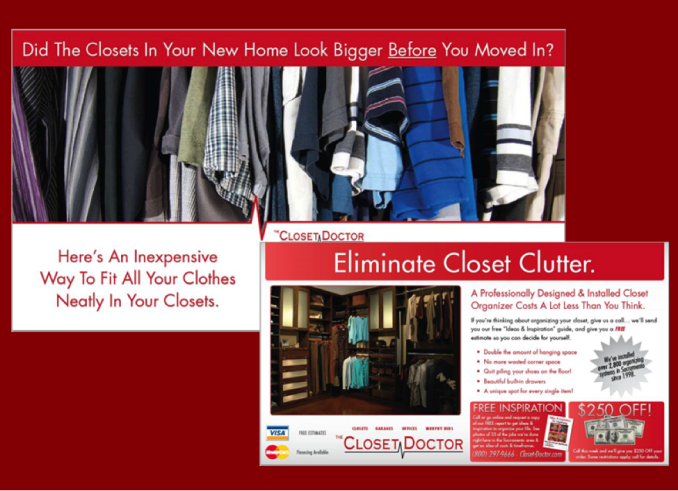Posted by Rich Harshaw on February 17, 2017.

Ever heard of “remainder advertising”?
If you haven’t heard the term, you probably know the concept.
Remainder advertising is unsold advertising space in newspapers, magazines, radios, and TV that you can buy for a discounted price.
It’s basically the “clearance” aisle at a department store. It’s the stuff no one wanted, so the seller marks it down because they figure it’s better to sell it at a discount than not at all.
In the past, clients have asked me whether it’s good business to buy remainder advertising.
My answer: It depends on your goals.
I’ll break down remainder advertising into its pros and cons, so you can judge for yourself whether it’s worth buying.
Cons Of Remainder Advertising
Let’s start with the bad.
When you buy remainder advertising, you have little to no control of when or where your ad runs, so you will not reach the same audience consistently. This makes remainder advertising a poor strategy if you’re looking to build a recognizable brand.
Remainder advertising can also be erratic. A station or publication could have two or three spots available one week, and zero spots the next three. It’s a crapshoot.
Pros Of Remainder Advertising
Besides the obvious advantage of saving money on ad space, remainder advertising can be a good direct response vehicle to generate immediate leads.
I’ll give you an example…
Back in 2003, we wanted to generate leads for a business opportunity and didn’t care when the leads came in.
We bought remainder advertising on the Rush Limbaugh show, which was broadcast on 530 radio stations.
The normal rate for a 60-second spot was $24,000, but we bought the show’s remainder advertising for $13,000 per spot. We saved 46% on ad space for one of the most popular radio shows in the country.
The show didn’t always have spots available; like I said, remainder advertising is erratic. But in this case, it served our business needs well because it produced an immediate ROI.
Bottom Line…
If you’re in “hunting” mode (i.e., direct response mode), remainder advertising is a good way to get leads right here, right now.
If, however, you’re a company doing $2 million or more per year that needs to build your brand, you have better avenues for doing so. You need to reach the same audience on a consistent basis to generate business for your company in the future. And you’re not going to do that if you’re randomly popping in and out of stations and publications.
So if you can’t decide whether to snatch up some unsold ad space, first determine your goals. That will give you your answer.
P.S. If buying media gives you a brain-splitting migraine, we can do it for you. We’ve bought over $100 million in radio, TV, and print media on behalf of our clients. We’ll meticulously research the market and individual stations/publications, and then negotiate rates that are among the best for those outlets. We can also create powerful, lead-generating ads for you. Find out more here.
Save
Posted by Rich Harshaw on February 13, 2017.

Let me tell you about the Curious Case Of Disappearing Yelp Reviews.
It’s pretty unnerving—especially if you’re a contractor whose online reputation relies heavily on Yelp.
Here’s the story…
I was talking to a client last week, and they’re currently having a huge problem with Yelp.
The client has been paying Yelp for advertising for several years now. The client started with a budget of a couple thousand a month and built it up to $10,000 a month.
Eventually, the client got frustrated with their inability to track the leads coming from Yelp. They were not able to distinguish which leads were coming from Yelp as a result of their ads vs. people just finding them on Yelp organically.
So at the end of December, the client yanked their ads. No spend in January.
That’s when the problem started.
Their five-star reviews mysteriously began to vanish.
January 1, 2017: 753 total Yelp reviews, 648 5-star reviews
January 31, 2017: 698 total Yelp reviews, 593 5-star reviews
Over the course of January, the client collected 43 new five-star reviews. Yet somehow they have substantially FEWER five-star reviews than they did BEFORE January.
What’s happening?
Simple… Yelp is steadily removing the client’s five-star reviews because the client stopped paying.
This is alarming, to say the least. The client has 50 one-star reviews; that means their ratio of five-star to one-star reviews shrunk from 13:1 to 12:1 in just 30 days.
This is not an anomaly, either. A quick Google search reveals Yelp’s “pay for play” system is common practice. In fact, they’ve been sued big time over this… and the circuit court judge ruled that it’s not illegal. Yelp says it’s just disgruntled customers who get bad reviews and suck and therefore complain.

Yelp scrubbing five-star reviews is surprisingly common.
When the client called Yelp and asked what the heck was going on, they made up some mumbo jumbo about “algorithms.”
Really? What kind of algorithm removes five-star reviews… and ONLY five-star reviews?
That’s a pretty funky algorithm for a REVIEWS company to implement. It would be like Priceline inventing an algorithm that randomly un-booked people’s trips, or Amazon developing a system that suddenly cancels customer orders.
Let’s call it what it REALLY is: Extortion.
Since online reputation is so important to this client (they’ve spent YEARS accumulating their reviews), and since Yelp is holding their five-star reviews for ransom, the client caved and started advertising on Yelp again at $1,000 per month. They feel like they have no other choice.
So far, though, it hasn’t helped. As of today, the client has 661 reviews and 563 five-star reviews. They are now at an 11:1 five-star to one-star review ratio.
I have no idea what can stop the bleeding, or even if it can be. I’m simply warning you…
Do NOT do business with Yelp. Period.
If you have reviews on Yelp, that’s fine. Just NEVER, EVER give them your money. And realize that your five-star could “mysteriously” vanish in an instant for any reason (usually because you are not giving them money).
Honestly, if you want to build your online reputation, there are better ways than Yelp… literally over 170 of them.
That’s roughly how many review websites exist (both nationally and locally). And MYM can help you build an ultra-stout online reputation on as many of them as you chose.
Our Online Reputation Management…
- Monitors customer reviews across all 170+ review websites
- Converts happy customers into glowing, sales-producing online reviews
- Can stop negative reviews BEFORE they happen
- Turns positive reviews into automated SEO-friendly web and social media content
- Provides regular comprehensive reporting regarding the “health” and status of your online reputation
All you have to do is keep performing the same great work, while we get your customers gushing about you online.
For more info, visit our Online Reputation Management page. Make sure you use the Free Review Scanner for an instant report on the health of your online reputation.
Save
Posted by Rich Harshaw on January 6, 2017.

Let me throw some numbers about new movers at you…
According to a recent Scarborough report, new homeowners are more likely than established homeowners (people who have lived in their homes for over three years) to invest in the following:
-
53% more likely to repair or replace their floors
-
47% more likely to replace their HVAC systems
-
47% more likely to have their homes painted
-
45% more likely to remodel their kitchens
-
34% more likely to replace their siding
-
33% more likely to augment their homes with additions
-
32% more likely to remodel their bathrooms
-
29% more likely to replace their windows
-
24% more likely to upgrade the exterior of their homes
-
14% more likely to get roof repair or replacement
In other words: New movers are a gold mine for contractors.
No “ifs.”
No “ands.”
No “buts.”
No bull.
Honestly, these numbers are no surprise. When people move into an existing home, there will always be at least one thing they want to change/remodel/renovate/add.
The question is, how do you make sure they spend their money on YOU?
The obvious answer is internet marketing: website, SEO, PPC, and so on.
But…
Do you want to know an even faster way to get in a new mover’s face and make them think of you—and ONLY you—when they consider their project?
Good old-fashioned direct mail… and lots of it.
I’m not talking about one or two mailers. If you only send a couple postcards, you’ll get crap results.
I mean hitting new movers consistently and frequently.
How consistently and frequently?
Let’s dive into the numbers and figure it out.
First, determine how much you normally spend on marketing to generate a sale.
Not a lead—a sale.
Example: Let’s say you spend $250 per lead and convert 33% of them into sales. That means you’re paying $750 per sale.
Next, estimate the percentage of new movers you think you can convert into a sale if you consistently and frequently mail to them.
What’s that? You don’t know how many you can convert?
Newsflash: No one ever knows for sure the results a marketing campaign will generate. Not even yours truly.
So let’s just go with a conservative estimate of 1%. That means you sell one job for every 100 people you consistently mail to on a regular basis.
This means you have a budget of—wait for it—$750 per 100 new movers to cover mailing costs.
Stop a second and take those numbers in.
If your mailings cost $0.50 per piece, that means you can afford to send 15 mailers to all 100 of those new movers ($750 x $0.50 / 100 people).
This lets you…
- Establish a rapport.
- Get the homeowners familiar with your name.
- Educate them about who you are, what you do, and why you do it better.
- Let them get settled in and start a project when they’re good and ready.
- Nudge them into taking action on the project they know they want or need to do.
- Outlast all the other guys who send a measly one or two (or zero!) mailers.
But why stop there?
If you want to get MAXIMUM mojo out of your mailers, here’s what you do…
After two or three months of mailing your new movers, hire someone to drive around and knock on their doors to see if they’re interested in a home improvement project. You’ll be pleasantly surprised at how open and willing to talk these new movers are.
Why?
Because a good chunk of them want what you sell… and they want it NOW!
Canvassing in today’s day and age may sound a little “old fashioned.” But try it and see what happens—I’m 99.7% certain you’ll experience great results as long as you mail your prospects frequently.
If you don’t want to take the time and effort to create a powerful direct-mail campaign, let us do it for you.
P.S. Here are some sample “new mover” mailers to get your brain juices flowing:




Save
Posted by Rich Harshaw on January 6, 2017.

Like 92% of the population, I read online reviews about something before I consider buying it.
This especially goes for big-ticket items like remodels, vacations, and vehicles.
So when I wanted to take my wife to a Cancun resort last year, I went to TripAdvisor to scope the online reviews of the different establishments.
Now…
When I plan vacations like this, I only consider resorts with at least an 80% (four out of five stars) rating. I’m spending a big chunk of change, and I want my money’s worth.
So I found a beach-side resort that ticked all the boxes I wanted: fun stuff to do, exotic location, all-inclusive, and the necessary rating I require (it had four stars with over 2,000 reviews).
I booked the resort two months in advance and went on my merry way.
Flash-Forward Two Months…
We arrive at the lush tropical resort, ready to relax and have fun.
But turns out that, within those two months in which I booked the trip and when we arrived, the resort began a MAJOR construction project.
In the words of Homer Simpson… D’OH!
Instead of being greeted by the soothing sounds of ocean waves crashing onto the beach, we were met with the obnoxious, ear-splitting cacophony of jackhammers crunching into concrete.
Instead of breathing in the salty sea air, I sucked up two lungful’s worth of construction dust every time I inhaled.
Instead of opening the window shades in my room to experience the beautiful tropical view, I had a construction worker’s butt crack staring back at me.
Twice.
By the end of the trip, I looked something like this:

The point?
If I had looked at the resort’s reviews within those two months, I would have seen a ton of new reviews complaining about the construction. And I would have canceled and booked a different resort. But I didn’t.
Oh, well. Live and learn.
Here’s what YOU can learn from my excruciating excursion.
Like the vacation industry, home improvement is a fluid business. CURRENT reviews are critical.
When I looked at the resort’s TripAdvisor page yesterday, the reviews painted an entirely different picture from when I booked it over a year ago.
Sure, some people are still giving it good reviews (they must have been far, far away from the construction site). But many of them now mention the STILL ongoing construction as a turn-off.
This leads me to a few questions for you…
Are there any companies you compete against that were good last year… or the year before… that are now terrible? And would their reviews tell that story?
Odds are, you do.
And trust me when I say people ALWAYS put more stock into current reviews than old ones.
If prospects see that a contractor has negative recent reviews, they’re going to look for someone else—period. Those shiny five-star reviews from one or two years ago won’t help.
But if you have a bunch of great reviews consistently pouring in, it can work wonders for your business.
That’s where ORM comes in.
With ORM, the good reviews pour in fast and furious… while helping to prevent any negative ones from being posted for all the World Wide Web to see.
Find out more on our ORM webpage. (Also, make sure you use our free Online Review Scanner for an instant snapshot of your online reputation across multiple review websites.)
P.S. Okay, our Cancun trip wasn’t ALL bad. Besides the resort construction, it was actually pretty great. We visited the Mayan ruins in the ancient city of Coba and did a cenote tour of the local underground caves and lakes. I don’t have the pictures on my computer, but here are a few photos I found online of the Coba ruins we saw:
Mayan Pyramid

Mayan Lighthouse

Stone Pyramid

Save




















